|
Root canal
treatment
Treatment is usually
performed in two visits and
involves the following steps:
1. We examine and x-ray the tooth,
and then administer a local
anaesthetic. After the tooth is
numb, Naomi places a small
protective sheet called a “rubber
dam” over the area to isolate the
tooth. This is an essential but
simple tool which also enables us
to use stronger cleaning agents
and keep it clean and free of
saliva during the procedure. It
also makes treatment more
comfortable for patients.
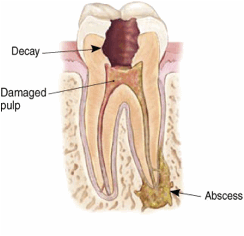
2. We then make an opening in the
crown of the tooth. Very small
instruments are used to clean the
pulp tissue from the pulp chamber
and root canals and to shape the
space for filling.
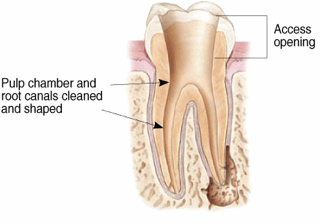
3. After the space is cleaned and
shaped, we fill the root canals
with a rubber like material called
gutta-percha which is
biocompatible. The gutta-percha is
placed with a cement to ensure
complete sealing of the root
canals. A temporary filling is
placed to seal the opening until
you can attend your dentist for
the final permanent restoration.
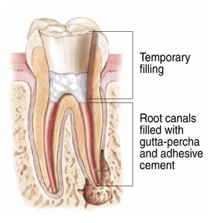
4. After the final visit with
Naomi, you must return to your
dentist to have a permanent
restoration placed on the tooth to
protect and restore it to full
function. In molar teeth ideally a
crown is placed.
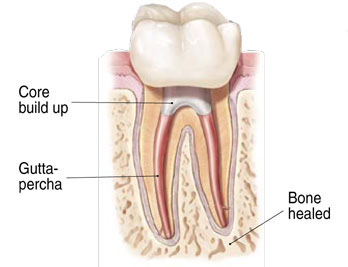
If the tooth lacks sufficient
structure to hold the restoration
in place, your dentist may place a
post inside the tooth.
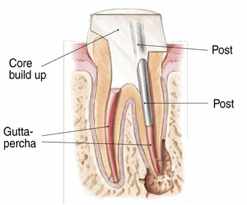
5. Review
appointments are included in the
treatment fee and we encourage all
our patients to return to the
practice for a review after a
minimum of 4 months (but usually
after six months to a year) to
assess for healing. This is
conducted at no cost and is an
important part of the treatment.
Naomi will advise you when you
will be due for a review.
Root canal
retreatment
Why do I
need another root canal
treatment?
The source of the initial
infection was bacteria and as
occasionally happens with any
dental or medical procedure, a
tooth may not heal as expected
after initial treatment for a
variety of reasons:
- Narrow or curved
canals were not treated during
the initial procedure.
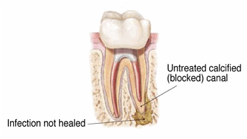
- Complicated canal
anatomy went undetected in the
first procedure.
- The placement of
the crown or other restoration
was delayed following the
endodontic treatment.
- The restoration
did not prevent salivary
contamination to the inside of
the tooth.
There are cases when
for a variety of reasons,
everything was not treated
optimally the first time around
and we are happy to retreat these
teeth with the aim of enhancing
the cleaning of the canals and
upgrading the root filling. As
with any medical procedure,
occasionally cases can still fail
even though everything may have
been previously treated to an
optimum. We would be reluctant to
retreat a case previously treated
by another endodontist or
ourselves if there were no
problems during the initial
treatment. In these cases we would
usually recommend surgery as the
next option.
In other cases, a new problem can
jeopardize a tooth that was
successfully treated. For example:
- New decay can
expose the root canal filling
material to bacteria, causing a
new infection in the tooth.

- A loose, cracked
or broken crown or filling can
expose the tooth to new
infection.
- A tooth sustains
a fracture.
Often, when this
happens, revision of the previous
treatment may be performed to save
the tooth.
What will happen
during retreatment?
The tooth is first
reopened to gain access to the
root canal filling material. In
many cases, complex restorative
materials—crown, post and core
material—must be disassembled and
removed to permit access to the
root canals.

After removing the
original canal filling, we clean
the canals and carefully examine
the inside of your tooth using
magnification and illumination,
looking for any additional canals
or unusual anatomy that requires
treatment.
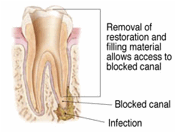
After cleaning the
canals, we will fill and seal the
canals and place a temporary
filling in the tooth. If the
canals are unusually narrow or
blocked endodontic surgery may be
recommended. This surgery involves
making an incision to allow the
other end of the root to be
sealed.
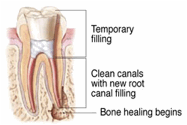
Once completed, you
will need to return to your
dentist as soon as possible to
have a new crown or other
restoration placed on the tooth to
protect and restore it to its full
function.

Surgery
Why would I need
endodontic surgery?
- Surgery can help
save your tooth in a variety of
situations.
- Surgery may be
used in diagnosis. If you have
persistent symptoms but no
problems appear on your x-ray,
your tooth may have a tiny
fracture or canal that could not
be detected during nonsurgical
treatment. In such a case,
surgery allows Naomi to examine
the entire root of your tooth,
find the problem, and provide
treatment, if feasible.
- Sometimes calcium
deposits make a canal too narrow
for the instruments used in
nonsurgical root canal treatment
to reach the end of the root. If
your tooth has this
“calcification,” Naomi may
perform endodontic surgery to
clean and seal the remainder of
the canal.
- Usually, a tooth
that has undergone a root canal
can last the rest of your life
and never need further
endodontic treatment. However,
in a few cases, a tooth may not
heal or become infected. A tooth
may become painful or diseased
months or even years after
successful treatment. If this is
the case, surgery may help save
your tooth.
- Surgery may also
be performed to treat damaged
root surfaces or surrounding
bone.
Although there are
many surgical procedures that can
be done to save a tooth, the most
common is called apicectomy or
root-end resection. When
inflammation or infection persists
in the bony area around the end of
your tooth after a root canal
procedure, Naomi may have to do an
apicectomy.
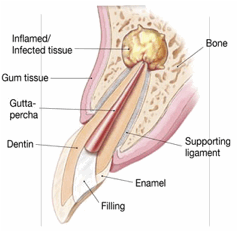
What is an
apicectomy?
In this procedure,
Naomi lifts the gum back to expose
the underlying bone and to remove
any inflamed or infected tissue.
The very end of the root is also
removed.
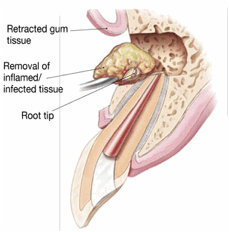
We clean up into the end of the
root using ultrasonics and then a
seal is placed into the root end.
Then the gum is placed into its
original position and stitches or
sutures are placed in the gum to
help the tissue heal properly. We
normally see you one week later to
remove the stitches and assess for
healing.
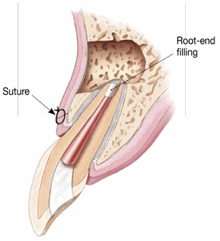
Over a period of months, the bone
heals around the end of the root.
Will the procedure
hurt?
Local anesthetics
make the procedure comfortable. Of
course, you may feel some
discomfort as this is a more
invasive procedure but usually
patients are surprised at how
quickly things feel normal. You
may experience pain, swelling or
bruising for a few days after the
procedure while the incision
heals. This is normal for any
surgical procedure. Naomi will
recommend appropriate pain
medication to alleviate your
discomfort and go through
post-operative instructions. You
will also have Naomi’s mobile
number in case you need to contact
her.
Can I drive myself
Home?
Usually you can, but
sometimes we recommend having
someone with you to bring you Home
as you might be tired after the
procedure.
When can I return
to my normal activities?
Most patients return
to work or other routine
activities the next day. Naomi
will be happy to discuss your
expected recovery time with you.
How do I know the
surgery will be successful?
If everything goes
well at the time of the surgery
and no cracks are detected in the
root the chances of success are
very high. Healing can only be
properly assessed with a
radiograph a few months after the
procedure. At the review
appointment we look for evidence
of bony healing at the root tip.
Occasionally a treatment can fail
although the patient experiences
no symptoms so it is important to
have your review appointment.
What are the
alternatives to endodontic
surgery?
Often, the only
alternative to surgery is
extraction of the tooth.
Occasionally nothing is placed
into the gap but the restorative
options to replace the gap include
an implant, bridge, or removable
partial denture to restore chewing
function and to prevent adjacent
teeth from moving. Because these
alternatives require dental
procedures on sometimes adjacent
healthy teeth, endodontic surgery
is usually the most biologic and
cost-effective option for
maintaining your oral health.
No matter how effective modern
artificial tooth replacements are
nothing is as good as a natural
tooth. You’ve already made an
investment in saving your tooth.
The pay-off for choosing
endodontic surgery could be a
healthy, functioning natural tooth
for the rest of your life.
Post removal
Prior to some dental
treatments, old posts sometimes
need removing or replacing. We
provide this service and your
dentist will advise if this is
required.
Images reproduced
with permission from the American
Association of Endodontists.
|